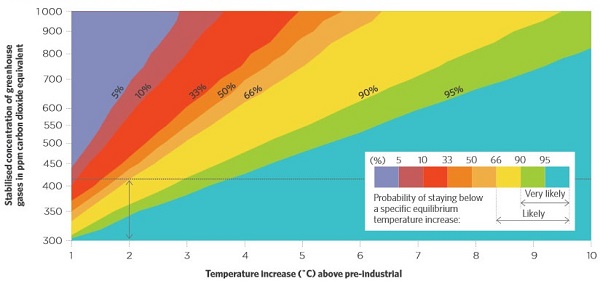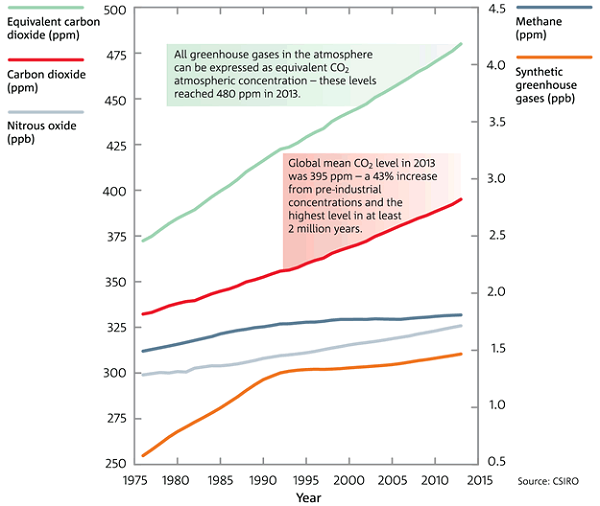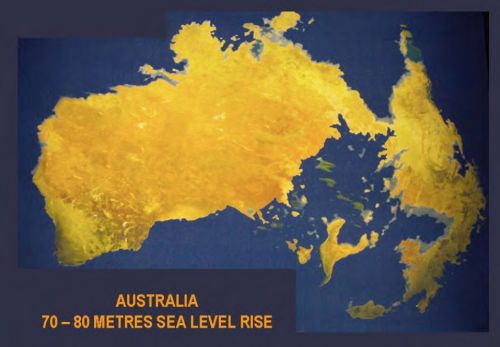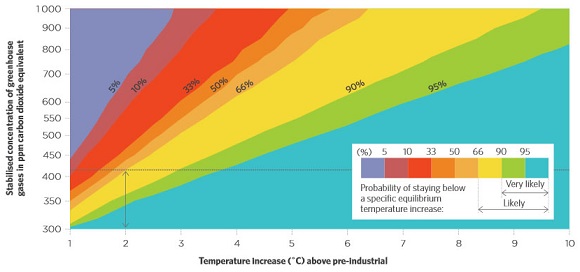In the post A choice of catastrophes: the IPCC budget approach I explained the socalled ‘carbon budget approach’ in some detail. In general terms:
- In a warming world what matters is the total quantum of CO2 in the atmosphere. The ‘climate budget approach’ identifies the total anthropogenic CO2 emitted to cause warming of 2°C. For a 66% chance of staying under 2°C the total CO2 emitted must not exceed 1000Gt, according to calculations done by Malte Meinshausen and others back in 2009. The later we leave cutting the harder we have to cut.
Rahmstorf’s budget was about 1000Gt of CO2 or about 1500GT of CO2 equivalent with other greenhouse gases for a 25% chance of staying within 2°C. Then
- as Giles Parkinson reports, the carbon budget figures have taken a haircut to become 800Gt for a 66% chance of 2°C when “accounting for non-CO2 forcings”. Problem is we’d already used up 543Gt of the budget by 2011.
David Spratt now tells it straight:
- We have to come to terms with two key facts: practically speaking, there is no longer a “carbon budget” for burning fossil fuels while still achieving a two-degree Celsius (2°C) future; and the 2°C cap is now known to be dangerously too high.(My bold)
He says we need to take a proper approach “around contingency planning for high-impact and what were regarded as low-probability events, which unfortunately are now becoming more probable”.
- If a risk-averse (pro-safety) approach is applied – say, of less than 10% probability of exceeding the 2°C target – to carbon budgeting, there is simply no budget available, because it has already been used up.
We all wish the incremental-adjustment 2°C strategy had worked, but it hasn’t. It has now expired as a practical plan.
There is no longer a non-radical option, only one path remains viable: the emergency ‘war economy’ mode.
- After 30 years of climate policy and action failure, we are in deep trouble and now have to throw everything we can muster at the climate challenge. This will be demanding and disruptive, because there are no longer any non-radical, incremental paths available.
Prof. Kevin Anderson and Dr Alice Bows, writing in the journal Nature, say that “any contextual interpretation of the science demonstrates that the threshold of 2°C is no longer viable, at least within orthodox political and economic constraints”.
Supporting Spratt’s view, in this post I drew attention to the following graph from Malte Meinshausen:

A 10% probability of exceeding the 2°C target suggests that we need CO2 levels of 350 ppm. As I said there we are currently at 480 ppm CO2 equivalent taking all greenhouse gases into account:

Given the gravity of possible impacts, for proper risk management I think we should be looking at a 99% chance of achieving a safe climate. Meinshausen’s graph doesn’t go that far. Reading from his graph, 480 ppm of CO2e should give us a 95% chance of staying within a temperature rise of over 5°C. Remember, Hansen tells us the ice sheets began to form 34 million years ago when CO2 levels were about 450 to 500 ppm. According to Spratt, this is what Australia would look like when the ice is gone:

It might take centuries or millennia, but that is our very possible legacy.
For a safe climate, we should be looking somewhere closer to 330 ppm.
At the very least our current situation demands the ambition and urgency specified by Professor John Wiseman, Deputy Director of the Melbourne Sustainable Society Institute at the University of Melbourne:
- He concludes that we need more ambition and urgency, both at the national and international levels. The achievement of emission reductions at the necessary scale and speed will require transformational rather than incremental change.
Wiseman goes for a three-phase emissions reduction target regime.
First, a 50% reduction target by 2020.
Second, zero net emissions by 2040.
Third, a carbon draw-down phase to get concentrations below 350 CO2e ppm.
In my view:
-
I applaud his ambition, but, personally, would change the date of the second to 2030 and put a date of 2050 on the third. That is, we should aim for 350 CO2e ppm by 2050.
Spratt quotes Prof. Kevin Anderson, who says:
- there is no longer a non-radical option, and for developed economies to play an equitable role in holding warming to 2°C (with 66% probability), emissions compared to 1990 levels would require at least a 40% reduction by 2018, 70% reduction by 2024, and 90% by 2030. This would require “in effect a Marshall plan for energy supply”.
Spratt quotes some high profile people as being aware of the situation:
- former UK government advisor Professor Sir Robert Watson says the idea of a 2°C target “is largely out of the window”, International Energy Agency chief economist Fatih Birol calls it “a nice Utopia”, and international negotiations chief Christiana Figueres says we need “a miracle”. This is because, in their opinions, emissions will not be reduced sufficiently to keep to the necessary “carbon budget”.
Figueres runs the UNFCCC whose Conference of Parties meets at the end of each year for two weeks. In Paris in 2015 they are scheduled to conclude a successor to the Kyoto agreement for implementation from 2020.
Ironically the very timetable bespeaks a lack of urgency.
Related posts:
Climate change: reconnecting politics with reality
A choice of catastrophes: the IPCC budget approach
Adding to the muddle? The IPCC climate change mitigation report


I guess the one piece of good news is the Lowy Institute survey showing that Australians’ concern about climate change is starting to rise
http://www.lowyinstitute.org/news-and-media/press-releases/australian-attitudes-heating-about-climate-change-2014-lowy-institute-poll-finds
The message that really needs to get out is that a “war on climate change” would provide the stimulus required to get the world economy out of the doldrums.
The other message to get out is that, once we have built all the necessary renewable power generation we are going to have very, very cheap power.
The lie that needs fighting right now is the economic lie, not the science lie.
Well, both, I think, John.
Val thanks for the link. I heard it on the radio but hadn’t time to follow up.